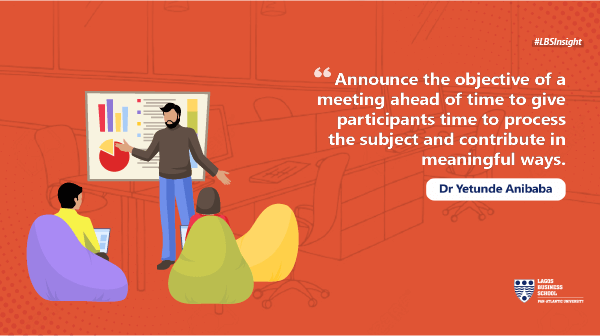Poorly run meetings are a drain on employee and organisational productivity. In the field of decision-making, we teach that optimal decision-making can happen in a 5-8 step process (depending on the author and the situation); and a few of these steps can be applied to redeem something that for many people, has become a drag on organisational life – meetings. From conversations with many managers over the years, it has been deduced that meetings have come to be accepted as that feature of work-life we must endure, at least, on a weekly basis. While some organisations stick with the conventional Monday morning, others schedule these meetings for later in the week. Whatever day they hold, meetings are a lot more effective when they are less draining on everyone’s time and energy – mental, emotional and physical.
To get the best out of meetings, there are at least two areas to focus on – the process, and the climate of the meeting environment. We will consider the first area in this piece, and the second in the next. We should clarify that there are various kinds of meetings and the following guide will apply to each kind. However, as a whole, it is probably most useful for decision-making and problem-solving meetings, but some elements are certainly useful for other kinds of meetings as well.
In order to have effective meetings, do these things:
- Determine that you actually need to have that meeting, or that you need to have it now. Sometimes, we show up in meetings and find that there is not enough information to make the meeting kick off in any meaningful way. At other times, it is just that we need to pass on information for which no real deliberation or action is required. The first thing you may need to do when you are thinking about calling a meeting is to determine if you can achieve the objective of the meeting using a more efficient medium such as email, or other forms of communication. Related to this is whether the meeting requires physical presence, or virtual engagement will do.
- If a meeting is required, what is the goal of the meeting? Put differently, at the end of this meeting, what must we have accomplished? What must everyone know, think or feel? We can easily confuse this with an agenda. An agenda lists activities and associated timelines. However, an objective is the beacon that helps everyone channel the mental, physical and emotional resources brought into the meeting efficiently and effectively. Therefore, it clearly helps a great deal in many scenarios, to announce the objective of the meeting ahead of time to give participants some time to have processed the subject and be able to contribute in meaningful ways. You should also remind everyone at the beginning of the meeting, and make it as concise as possible.
The way you frame the objective is also important. Consider this example: ‘the objective of this meeting is to discuss how to take this unit forward’ – that is exactly what you will end up with – a discussion! Consider re-framing it this way: ‘to identify measures that will help this team grow its productivity by 10% over the next quarter’. The first one is excessively broad and without clear metrics for measuring whether the meeting succeeded or not. With the second one, however, we are clear that the focus is on the next quarter, and we want to grow team productivity by 10%.
Being clear about the objective of the meeting also helps to minimize the possibility that participants will veer off in different directions, thereby elongating the meeting unduly and diverting the focus of attention.
- Now that we are clear on the goal(s) we want to achieve, we will naturally begin to generate various ideas by which we can achieve the objective for the meeting; in our example above that would be various ways we can increase our team’s productivity by 10% in the following quarter. Naturally, these ideas will probably happen within the context of our knowledge of our organisation, the work that we do and how we do it. But how do we determine which idea(s) will achieve our objective in the most optimal way?
It is important to agree on and explicitly state the boundary conditions the option(s) must fulfil in order to be accepted as the best option for improving our productivity as a team. In other words, what are the criteria/parameters by which you will evaluate the options? For example, one of the ideas put forward is TGIF in a restaurant located in a highbrow neighbourhood every month. While this idea may be great for ensuring we are refreshed, bonded and ready to be more productive in the following month, its cost may be prohibitive and therefore not likely to be the most optimal way to achieve our objective. Ideas are a dime a dozen, it is important to have explicit parameters agreed on by the team, by which you will evaluate the ideas, so we are all able to get on the same page regarding the final choice. Those parameters/criteria, if articulated correctly, also help to determine upfront, that the option we select is practicable.
- Finally, we should recognize that just choosing an option for achieving our objective is not the end of the road. We should not leave the meeting without agreeing on resources, timelines and responsibilities, otherwise, we would have just gone through an academic exercise.
In the second part of this piece, we will consider the soft issues that are really where ‘the rubber meets the road’ as far as effective meetings go.


